问题的提出:
俄罗斯方块允许90度的坡,是不是有点不够科学#(滑稽)
想办法加一种会“滑坡”的方块
本文两大部分:
详细的描绘是怎样的“流动”
写代码,并整合进游戏
本文基于我写的
事先上两个动图, 说明下我想做什么


第一部分
首先是假象图

这是一个长条逐渐“瘫软”的过程
归纳规律,其实只有两种移动
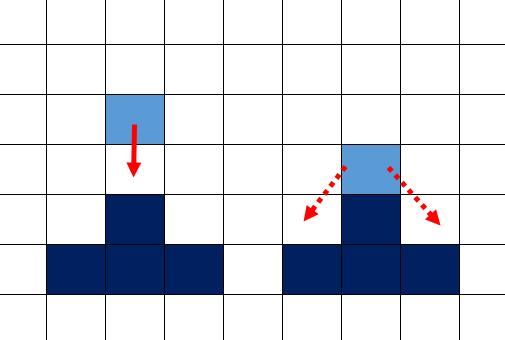
1下方没有方块时:向下方滑落
2下方有方块时:向左下或者右下滑落
但是这两条是不够的
下面展示一种例外
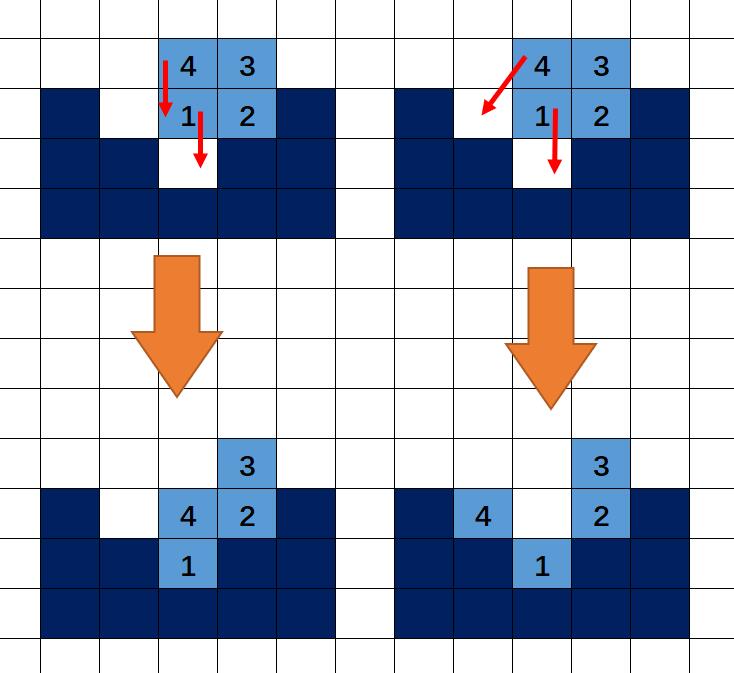
左边的比右边“更科学”
显然,需要再加一条规则“规则三:下方的方块先行动”
但是,这个规则还不够,我又找到两个“不科学的”例子

左边的比右边“更科学”
不同行之间需要区分次序,同一行的也要区分次序!!!
行内从左向右,和从右向左都无法从根本解决问题,那就只能调整两种移动的优先级
再加一条规则“规则四:同一行的,下落移动的优先”
接下来还有一个“不科学”

进去了。。。这是最不科学的一个。。
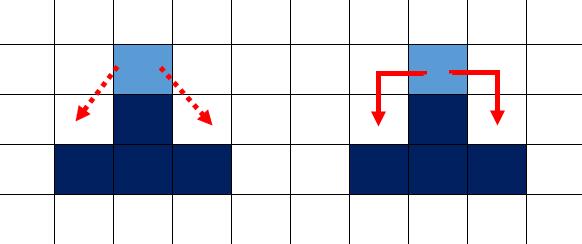
添加一条斜向移动的限制“左右有方块不可斜向移动”
然后我发现,规则四没用了!!!

说明:1号方块的斜向移动被2号阻止了,上面的情况变成“不可能发生”
它们解决的是同一个问题,水平相邻方块之间的次序问题
只是限制斜向移动的方法更为彻底!
规则汇总:
1下方没有方块时:向下方滑落
2下方有方块且左下右下为空时且无阻碍时:向左下或者右下滑落
3多个方块,行数小的方块先行动
我已经尽力的考虑每一种“例外”了,如有疏漏欢迎指出
第二部分
代码的问题无非两个:
怎么写
什么时候执行
先说第二个问题
什么时候执行
讲流程,原来的“方块落地-->清算分数-->下一个方块” 新的 "方块落地-->开始流动-->清算分数-->下一个方块"
可是一次流动结束就太没趣了 一次只流动一步
之前的下落过程的流程图
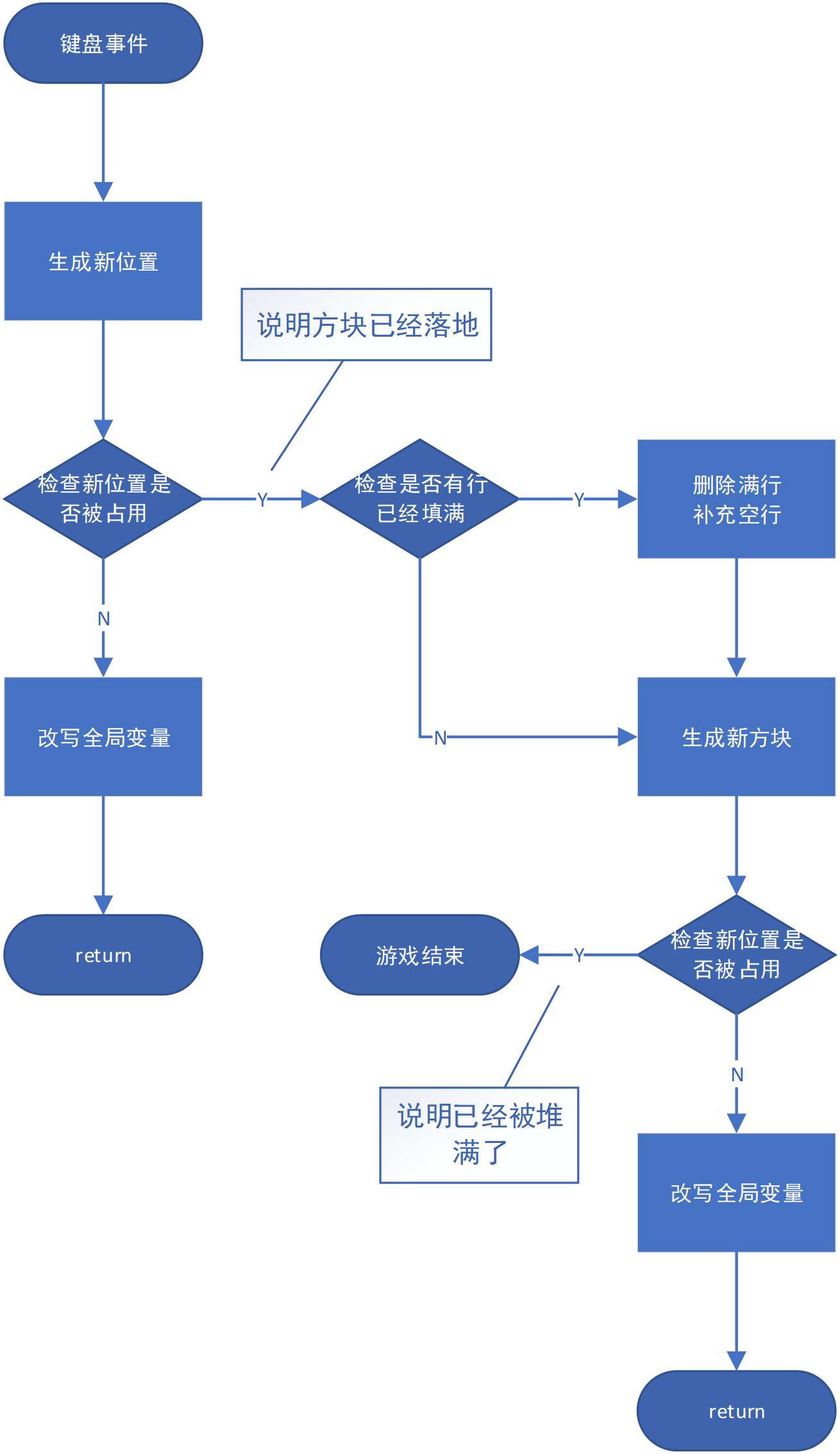
新的

代码重整
# flows list 全局变量 储存"正在流动的方块" # block_type list 全局变量 决定活动方块能否流动 def move_down(): if flows:
# ---------流动过程--------- pass # ========================== else: # 下面是常规的流程 x, y = centre x -= 1 for i, j in active: i += x j += y if background[i][j]: break else: centre.clear() centre.extend([x, y]) return # ----------落地后------- # 如果方块状态 为 流动 则写入flows if block_type[0] == 2: x, y = centre for i, j in active: flows.append((x + i, y + j)) # === 将方块信息 转入 待流动列表 active.clear() return # 结束函数,防止进入下方"清算环节"
# - 否则走常规流程 else: x, y = centre for i, j in active: background[x + i][y + j] = 1 # -----检查是否满行----- l = [] for i in range(1, 20): if 0 not in background[i]: l.append(i) l.sort(reverse=True) for i in l: background.pop(i) background.append([0 for j in range(10)]) score[0] += scores_f(len(l)) pygame.display.set_caption("分数:%d" % (score[0])) active.clear() new = list(random.choice(all_block)) if random.randint(1, 10) >= 4 else list(random.choice(all_block_plus)) active.extend(new) block_type[0] = 1 if random.randint(1, 10) >= 5 else 2 # 取个随机数,决定下个方块的类型 1为普通方块 2为流动方块 centre.clear() centre.extend([20, 4]) x, y = centre for i, j in active: i += x j += y if background[i][j]: break else: return alive.append(1)
下面是流动的详细内容:

PS:从流动列表移除的同时 , 应该写入 background "固化"成为背景
流动过程代码(在最后有 红色代码额外的说明)
# 基于"遍历过程中避免修改遍历对象"的原则 # 故遍历 flows的 拷贝 flows_copy = flows.copy() # - 流动原则三,行数小的先动, 故遍历前先排序 flows_copy.sort() for i, j in flows_copy: flows.remove((i, j)) # 1 # '抹去'旧方块位置信息 if background[i - 1][j] or ((i - 1, j) in flows): # 如果下方有方块(背景方块,流动中的方块都算) # 2 num = 0 # 如果左侧没有方块(背景方块,流动中的方块都算)num += 1 if j >= 1 and (not background[i][j - 1]) and (not background[i - 1][j - 1]) and ((i, j - 1) not in flows) and ((i - 1, j - 1) not in flows): # (3) num += 1 # 如果右侧没有方块(背景方块,流动中的方块都算)num += 2 if j <= 8 and (not background[i][j + 1]) and (not background[i - 1][j + 1]) and ((i, j + 1) not in flows) and ((i - 1, j + 1) not in flows): num += 2 #num可能的情况 0 1 2 3 #对应 左右均不通 仅通左路 仅通右路 左右均通 #如果左右均通 左右两路随机选一个 if num == 3: num = random.randint(1, 2) # 根据num取值 做出相应的移动 if num == 0: # 这里与 流程图 不一致 后面会说明原因 (4) if (background[i - 1][j]) and (j <= 0 or background[i][j - 1] or background[i - 1][j - 1]) and (j >= 9 or background[i][j + 1] or background[i - 1][j + 1]): background[i][j] = 3 #如果 三个方向 被背景方块 堵死 #就"固化/停止流动/移出flows/写入background" else: flows.append((i, j)) elif num == 1: flows.append((i - 1, j - 1)) elif num == 2: flows.append((i - 1, j + 1)) else: # 否则就将算出 下方的坐标 添回flows flows.append((i - 1, j)) # 如果flows仍有方块存在 # return 结束函数, 防止 if flows: return
额外的说明:
1, 移动就是, 从flows除去旧的位置,添入新位置,,,为避免代码重复出现,循环第一步就移除旧位置
2,至此,方块有两种,background的背景方块 flows的流动方块 一个位置是否有方块 需要查阅两次 另外画面绘制部分需要 遍历 flows 绘制方块
3,为避免 越界错误 ,索引background前 加个判断
4流程图未考虑到一个特殊情况
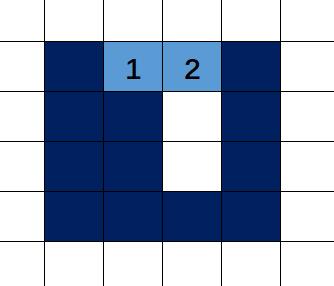
理想状态下 两个流动方块应该 填上洞 但是按流程图 1 号方块三路堵死 固化
所以 因流动方块 阻碍 造成的"假死"不用固化 / 单纯被 背景堵死 才固化
完整代码
import pygame, sys, random, time def new_draw(): screen.fill(white) for i in range(1, 21): for j in range(10): bolck = background[i][j] if bolck: pygame.draw.rect(screen, colors[bolck], (j * 25 + 1, 500 - i * 25 + 1, 23, 23)) x, y = centre for i, j in active: i += x j += y pygame.draw.rect(screen, colors[block_type[0]], (j * 25 + 1, 500 - i * 25 + 1, 23, 23)) for i, j in flows: pygame.draw.rect(screen, yellow, (j * 25 + 1, 500 - i * 25 + 1, 23, 23)) pygame.display.update() def move_LR(n): """n=-1代表向左,n=1代表向右""" x, y = centre y += n for i, j in active: i += x j += y if j < 0 or j > 9 or background[i][j]: break else: centre.clear() centre.extend([x, y]) def rotate(): x, y = centre l = [(-j, i) for i, j in active] for i, j in l: i += x j += y if j < 0 or j > 9 or background[i][j]: break else: active.clear() active.extend(l) def move_down(): if flows: flows_copy = flows.copy() flows_copy.sort() for i, j in flows_copy: flows.remove((i, j)) if background[i - 1][j] or ((i - 1, j) in flows): num = 0 if j >= 1 and (not background[i][j - 1]) and (not background[i - 1][j - 1]) and ((i, j - 1) not in flows) and ((i - 1, j - 1) not in flows): num += 1 if j <= 8 and (not background[i][j + 1]) and (not background[i - 1][j + 1]) and ((i, j + 1) not in flows) and ((i - 1, j + 1) not in flows): num += 2 if num == 3: num = random.randint(1, 2) if num == 0: if (background[i - 1][j]) and (j <= 0 or background[i][j - 1] or background[i - 1][j - 1]) and (j >= 9 or background[i][j + 1] or background[i - 1][j + 1]): background[i][j] = 3 else: flows.append((i, j)) if num == 1: flows.append((i - 1, j - 1)) if num == 2: flows.append((i - 1, j + 1)) else: flows.append((i - 1, j)) if flows: return else: x, y = centre x -= 1 for i, j in active: i += x j += y if background[i][j]: break else: centre.clear() centre.extend([x, y]) return if block_type[0] == 2: x, y = centre for i, j in active: flows.append((x + i, y + j)) active.clear() return else: x, y = centre for i, j in active: background[x + i][y + j] = 1 l = [] for i in range(1, 20): if 0 not in background[i]: l.append(i) l.sort(reverse=True) for i in l: background.pop(i) background.append([0 for j in range(10)]) score[0] += scores_f(len(l)) pygame.display.set_caption("分数:%d" % (score[0])) active.clear() new = list(random.choice(all_block)) if random.randint(1, 10) >= 4 else list(random.choice(all_block_plus)) active.extend(new) block_type[0] = 1 if random.randint(1, 10) >= 5 else 2 centre.clear() centre.extend([20, 4]) x, y = centre for i, j in active: i += x j += y if background[i][j]: break else: return alive.append(1) def scores_f(n): if n in scores: return scores[n] else: return scores_f(n-4) pygame.init() screen = pygame.display.set_mode((250, 500)) pygame.display.set_caption("俄罗斯方块") fclock = pygame.time.Clock() all_block = (((0, 0), (0, -1), (0, 1), (0, 2)), ((0, 0), (0, 1), (-1, 0), (-1, 1)), ((0, 0), (0, -1), (-1, 0), (-1, 1)), ((0, 0), (0, 1), (-1, -1), (-1, 0)), ((0, 0), (0, 1), (1, 0), (0, -1)), ((0, 0), (1, 0), (-1, 0), (1, -1)), ((0, 0), (1, 0), (-1, 0), (1, 1))) all_block_plus = (((-1, -1), (-1, 0), (-1, 1), (0, -1), (0, 0), (0, 1), (1, -1), (1, 0), (1, 1),), ((-1, 0), (0, -1), (0, 0), (0, 1), (1, 0)), ((-1, 0), (0, -1), (0, 0), (0, 1), (1, 0), (-2, 0)), ((0, -1), (0, 0), (0, 1), (1, -1), (1, 1)), ((-1, 1), (0, -1), (0, 0), (0, 1), (1, -1)), ((-1, -1), (0, -1), (0, 0), (0, 1), (1, 1)), ((-1, -1), (-1, 1), (0, 0), (1, -1), (1, 1)), ((-1, -1), (-1, 1), (0, -1), (0, 0), (0, 1), (1, -1), (1, 1)), ((-1, -1), (0, -1), (0, 0), (0, 1), (1, -1)) ) '''3x3,十,十,凹,2,5,X,H,T''' scores = {0: 0, 1: 1, 2: 3, 3: 6, 4: 10}
background = [[0 for i in range(10)] for j in range(24)] background[0] = [1 for i in range(10)] active = list(random.choice(all_block)) centre = [20, 4] score = [0] flows = [] block_type = [1] black = 0, 0, 0 white = 255, 255, 255 blue = 0, 0, 255 yellow = 255, 215, 0 colors = {1: blue, 2: yellow, 3: (139, 105, 20)} times = 0 alive = [] press = False while True: for event in pygame.event.get(): if event.type == pygame.QUIT: sys.exit() elif event.type == pygame.KEYDOWN: if event.key == pygame.K_LEFT: move_LR(-1) elif event.key == pygame.K_RIGHT: move_LR(1) elif event.key == pygame.K_UP: rotate() elif event.key == pygame.K_DOWN: press = True elif event.type == pygame.KEYUP: if event.key == pygame.K_DOWN: press = False if press: times += 20 if times >= 100: move_down() times = 0 else: times += 1 if alive: pygame.display.set_caption("over %d分" % (score[0])) time.sleep(3) break new_draw() fclock.tick(100)
PS : 标红的是一些细枝末节 有需要的话我再解释
流动方块降低了难度,,所以加入了一些 特殊形状的 方块增加难度
这篇急于发表 毕竟写了一个月了...有问题有空再更新
#